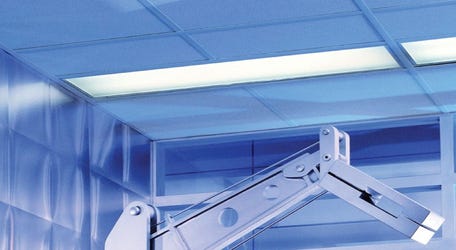ASTM calculations for walls and ceiling acoustics (CAC+NRC)!
The ASTM standard that dictates the minimum acoustic performance rating of both walls and ceilings uses two types of calculations: CAC (Ceiling Attenuation Class) and NRC (Noise Reduction Coefficient).
The ASTM standard also includes recommendations on how to perform these calculations so they can be easily verified by third parties such as building inspectors or local governments.
The CAC calculation determines the amount of sound absorption in the material, while the NRC calculates the amount of sound reflection from the material.
But, we'll get into more details below.
All you need to know about CAC Rating
The CAC rating is an acoustical rating that defines how well a room will absorb sound and help to control noise.
This is important in any space where you need to minimize the noise, especially in conference rooms where you have to consider speech privacy and keeping outside sound out.
The CAC rating is typically applied to walls and ceilings; however, it can also be applied to flooring systems as well.
It's a numerical measure of how much sound a ceiling tile attenuates or absorbs sounds in a given frequency range (usually 125 Hz - 4,000 Hz).
The higher the number, the better the tile will absorb sound.
The CAC rating applies to only one sound frequency at a time; however, using this method allows for more accurate sound absorption measurements.
CAC is required when classifying acoustical ceiling products in accordance with ASTM E1264
The more effective an acoustical product is at preventing sound transmission, the higher its CAC rating will be.
It denotes the capacity of a suspended acoustic ceiling to block sound flowing through a plenum when the wall does not reach its full height.
So:
CAC<25 is considered low performance
CAC > 35 is considered excellent performance
Keep in mind that when it comes to closed plan spaces, CAC=35 should be the minimum requirement.
The CAC value is calculated by subtracting the laboratory-measured sound attenuation of a ceiling assembly from the reference value of 100.
The calculation is based on "ASTM E1414: Standard Test Method for Airborne Sound Attenuation Between Rooms Sharing a Common Ceiling Plenum", which requires testing over a range of octave band frequencies, between 125 Hz and 4000 Hz.
The resulting data points are averaged to create an average sound attenuation in decibels (dB) between the areas.
CAC is crucial between closed places that require privacy, and also between closed spaces that need to be connected.
Such as:
- Closed offices to hallways
- Classrooms to group learning areas
- Healthcare offices and exam rooms to waiting rooms
The factors that determine the CAC rating include:
- The thickness of the wall
- The type of material used
- The density of that material
- The amount of absorption on either side of the wall

All there is to know about NRC rating
In order to understand what an NRC rating is all about, it's important to know a little bit about wall and ceiling construction in regards to sound blocking.
The most basic components of a wall or ceiling are wood or steel studs or joists, which are set 16 inches apart from one another in order to create airspace between them.
Once they're installed, drywall is placed into that space, while acoustic materials like fiberglass batting can be added as well.
These products improve sound blocking because they do not vibrate when sound waves hit them.
When you factor in all of these components -- studs, drywall and battings -- it's possible to get an idea of how well-soundproofed a room is based on an NRC rating.
NRC is a measurement that indicates the level of noise absorption a material provides.
The NRC rating is the average amount of sound absorbed by a product when measured at four frequencies (250Hz, 500Hz, 1000Hz and 2000Hz).
The NRC rating is 0.00 to 1.00. The higher the number, the more sound absorbing capability the product has.
For example, if you compare two products and one has an NRC rating of 0.45, and the other has an NRC rating of 0.85, the latter is better at absorbing sound.
Also, NRC= 0.90 means that the object or material absorbed 90% of the sound, and 10% of the sound bounced off it.
So:
NRC < 0.50 is considered low performance,
NRC > 0.70 is considered high performance
An NRC value can be used to determine how much sound will be absorbed by an object when you know its area, thickness and type of material.
So what does this mean for your acoustic performance?
It's important to note that no material can absorb 100% of the sound, and you will likely need multiple materials in your space to achieve balanced acoustic performance.
There will be trade-offs, so if you're looking for an extremely sound-absorbing material, then you should be prepared to compromise on aesthetics or durability.
For example, a soft, thick blanket may offer excellent acoustic performance, but it might not work well for your office space!
How is NRC calculated according to the ASTM C423?
The NRC rating of a product is required when classifying the acoustic performance of ceiling products in accordance with ASTM C423: "Standard Test Method for Sound Absorption and Sound Absorption Coefficients by the Reverberation Room Method."
The ASTM C423 test measures a material's ability to absorb sound in a 250Hz to 2,000Hz range.
After all, NRC is necessary for any space where noise levels and reverberation time are issues.
The test involves measuring how much sound is reflected from material and comparing it to how much sound is reflected from an open ceiling tile.
To determine the NRC, the sound is introduced into a small reverberation chamber.
An opening or mount is placed on one side of the room so that the material sample to be tested can be inserted into the opening or mounted on it.
The mount has no acoustical properties and does not contribute to the noise absorption values measured for the sample.
Different types of materials are tested at eight different frequencies, as we mentioned above.
The average sound absorption coefficient for each frequency is determined by measuring the sound energy in the room before and after inserting the material sample.
The difference between the two results is what gives us the NRC number, which will range from 0 – to 1.
Achieving perfect acoustic performance
To meet your space's sound-insulation needs, you can rely on acoustical ceiling panels that combine both blocking and absorption in one panel.
These panels incorporate the latest technology by giving you both a high CAC and NRC.
This means you must choose products with a CAC rating of 40 or higher and an NRC rating of 0.70 or higher.
For example, you can choose between USGME Celebretto Strip ceiling, Louna™ Hi CAC Acoustical Ceiling (CAC=42, NRC=0,90), and Louna™ Hi CAC Black Acoustical Ceiling (CAC=42, NRC=0,90)
Because these ceiling tiles and panels cover both acoustical needs, they're the ideal solution in spaces ranging from offices to classrooms, auditoriums, music & sports halls and restaurants.
Remember, if your material does not have these ratings, it may have a negative impact on your project's sound attenuation values!
When in doubt, look up your product's ASTM ratings before beginning installation.
Closing remarks
Finding out how sound moves through an enclosure can be difficult if you are not familiar with what noise you are trying to mitigate or exactly where it comes from.
However, ASTM makes things easier by providing calculation forms that take away much of your guesswork.
Whether you need to mitigate impact noise in your open-plan office or speech privacy in a meeting room, using ASTM guidelines will ensure that your building meets its needs without sacrificing acoustical integrity.
And remember that you need ceiling panels that provide the ideal combination of noise reduction (NRC) and sound blocking (CAC.)
This will allow you to help keep noise levels down and private conversations...private.










